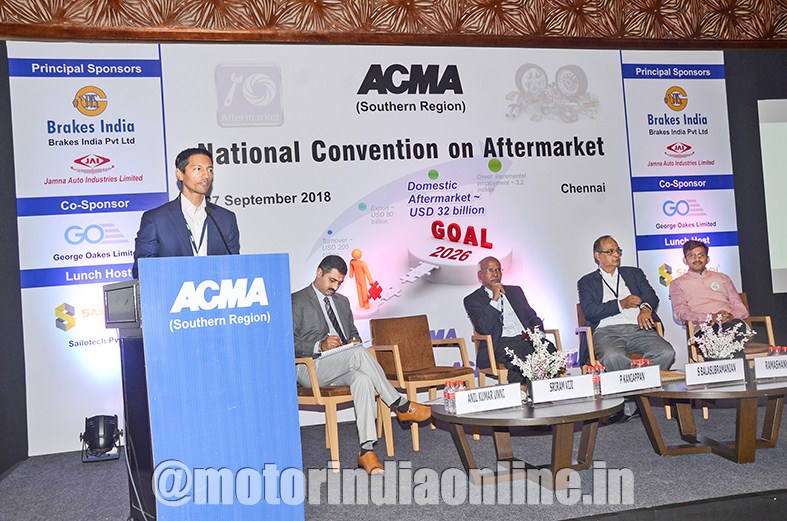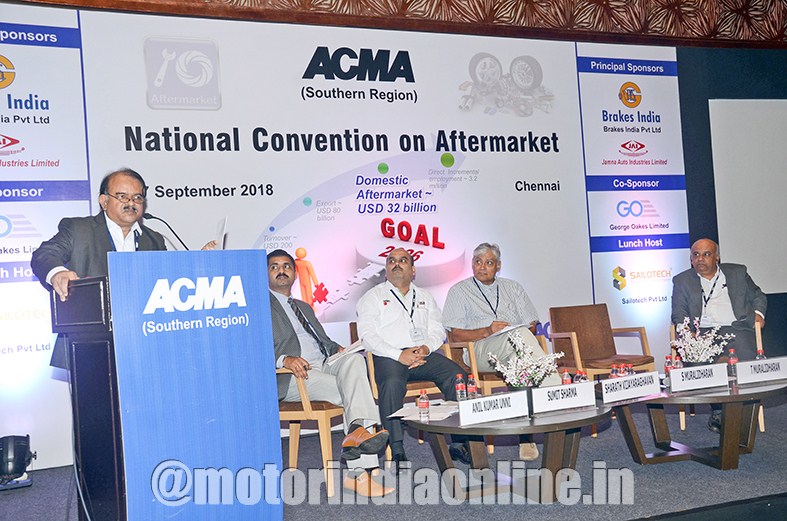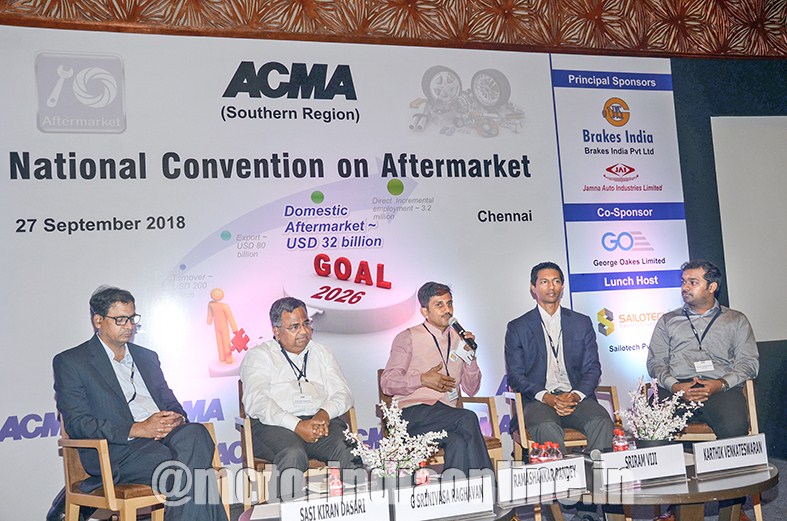According to Mr. Sriram Viji, Convention Chairman and Deputy Managing Director, Brakes India Pvt. Ltd., the Indian aftermarket has always been a huge area of focus for ACMA. By 2026, the projections made reveal that the Indian aftermarket is set to grow to touch $32 billion.
The convention witnessed presentations and panel discussions highlighting the important aspects such as the challenges, opportunities, future of the aftermarket and the need for stepping up efficiency.
The first plenary session was on ‘Creating an Efficient Distribution Supply Chain.’ This session, moderated by Mr. Sharath Vijayaraghavan, Executive Director, Sundaram Motors, gave a broad perspective on how companies can create an optimal delivery chain to improve business and find out what is best for them.

Mr. Sumit Sharma, Head – Aftermarket, Fleetguard Aftermarket, and a pioneer in the use of TOC, spoke about how his company focused on creating an effective supply chain by directly linking up with the stockers. “Our motto reads ‘Service, Customer, on time, every time’, and we make sure that significant changes are effected with our initiatives. We aim at improving availability, increasing our returns and investment and providing value to our customers”, he said.
Mr. S. Muralidharan, President, Lucas Indian Service Ltd., in his address, said how supply chains are no more than statistics. There is definitely scope for having a direct supply chain with the end user is possible. “Logistics costs are significantly high in our country, and supply chains have gone global. It is now cheaper and easier to get parts or components from Thailand than from places within India”, he added.
Mr. Ramashankar Pandey, Chairman, ACMA Aftermarket Committee, and Managing Director, Hella India Lighting Ltd., moderated another important panel session on the topic ‘Innovation & New Business Models in Aftermarket’.
He said: “We (ACMA) need to be ready for changes. We believe that changes will happen and we are preparing the ground rules, that is, to build standards.”
Further, ACMA plans to build an ecosystem in the aftermarket. It is not easy to set up an ecosystem as with the OEMs, as the aftermarket is multi-brand. The two important steps that should spring out of the discussions are to build a platform for retail and another for technicians.
“This should be a public platform like UPI or Mastercard. If we trust one another in India. Building such platforms will help it become a one of the kind in the world”, he added.
Mr. Sasi Kiran Dasari, Practice Head – Analytics Sailotech Pvt. Ltd., observed that the world is moving towards technology upgradation and that all the components and designs have begun leaning towards being technologically advanced. “Adopting technologies, but only to the extent of what we can bear, and not overexploiting ourselves, is critical”.
Mr. Karthik Venkateswaran, Co-Founder, goBumpr, said that whenever a transformation disruption occurs, only one company or a manufacturer comes out as a leader. “The second is a distant one. And even as an external player comes in with capital, he would still remain a player. But how customer-centric we are never changes”, he said.

Mr. Venkateswaran disclosed that the Indian automotive aftermarket is the byproduct of manufacturing. “We don’t have individual customer data of their own need and aftermarket. If we really want to increase our margins, we need to treat the aftermarket as a separate business segment rather than just a manufacturing segment”.
Mr. Sriram Viji emphasised that companies should observe and learn how other players in the business satisfy the customer needs, how their demand is generated and how they create the brand which the supply chains follow. “Every independent company has its own system of reaching out to the mechanics, and there is a lot of efforts going into that. So, if there are ways to get numerous training programs and certification programs for mechanics, then it will make it easy for manufacturers to have a say of what is happening in the economy”.
In the second half of the day, the Plenary 2 session, moderated by Mr. S. Balasubramanian, Executive Director, Frost & Sullivan, discussed the ‘Future and Impact of OES’.
Mr. S. Parthasarathy, CEO, Rane Madras Ltd., in his presentation, referred to the serious threat for the OES segment due to various factors. “Over the last 20 years, there has been a significant drop in the margin of profit for the OES segment. Hence the OEMs should make a note of this and support the component manufacturers to make at least a reasonable profit if not an exciting one. Also, the independent aftermarket should use bigger distributors to get the right feedback”.
Mr. S. Sivakumar, Vice-President – Aftermarket, WABCO India Ltd., in his presentation, said that OEMs, even today, are practically driving the market with their own pricing policy. “In order to meet the requirements of the price-sensitive aftermarket segment, WABCO has recently come out with its new PROVIA brand products for the overseas market.”
He also emphasised that there had been a huge pressure on price and delivery in the aftermarket segment.
The last session of the national convention witnessed some exciting viewpoints on the ‘Challenges and Opportunities’ faced by the aftermarket segment.
In his address, Mr. Muralidharan pointed out that, out of the Rs. 55,000-crore aftermarket segment, 40% business is with the OES category. In order to address various issues, the retailers should focus on three important factors, namely, environment, technology and distribution.
Mr. Mukund S. Raghavan, President, India Motor Parts & Accessories Ltd. (IMPAL), said that, with the introduction of GST, the retailer has become a responsible citizen by paying the due taxes. “The retailers are now also equally responsible person for the product sale”, he added.

“With the Government taking all-out measures for the turning of wheels for the betterment of economy through various initiatives that include building roads, introduction of Euro 6 norms, etc., the opportunities are galore,” Mr. Raghavan said.
He also mentioned that it is very proud to be representing India where growth opportunities are in abundance.
Mr. Nagaraju Srirama, President & Director, J.K. Fenner India Ltd., spoke about the journey of the Indian auto component industry, touching the various aspects of the past, present and the future. In the era of globalisation, India is in no way different from other countries.
“Earlier, a vehicle user changed the fan belt after every 5,000 km, whereas Fenner is working on developing a product which can give a longer life”.
Mr. Srirama also said that, with 49% of manufacturing GDP coming from the automotive sector, the Indian automotive industry will grow for the next 15 years. “At present with an excellent logistics network, auto component manufacturers in the UK are able to deliver the parts within 2 to 4 hours to the garage owners. This may happen in India in the future as well.”
Mr. Sandeep Begur, Director & Co-Founder, KooversCarCare, shared his experiences on the ‘Challenges & Opportunities’ faced by the aftermarket segment.
Mr. R. Srivatsan, Senior Faculty, National Academy of Customs, Indirect Taxes and Norcotics, Southern Zone, who was the last speaker of the convention, attracted each and every one by presenting the merits and benefits of GST which he considers a great step towards transparent approach.
The overall success of the ACMA National Convention goes to the excellent efforts taken by Mr. Anil Kumar Unni, Senior Director and Regional Secretary, ACMA (Southern Region). He has been contributing a lot for the ACMA Southern Region’s various key initiatives.